Yes, we’ve finally got to that point where we had to put together a comprehensive design for how combat works in Clockwork Empires. So let’s talk a bit about it.
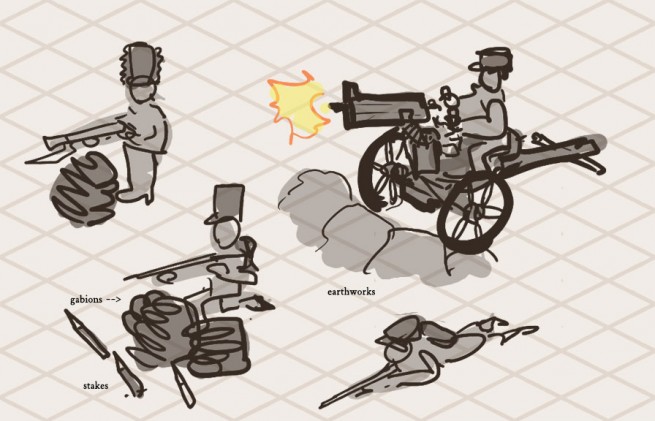
Not an in-engine screenshot.
We’ve all played lots of games and almost all of them are about combat in one way or another so this seems like it should be a fairly straightforward problem to solve. But CE is not like most games; Not at all. Combat is not the central game mechanic and focus for the game, merely one possible component in a much larger system. It can’t be allowed to take over the game and unduly tax a player’s attention, nor should it be irrelevant or some kind of tacked-on side-game as seems to be the pitfall of combat systems for a number of classic city-builder games. In CE, combat should tie in with as many other game systems as possible so that it supports the other mechanics in play and in doing so enriches the overall experience. Simple enough, eh!
With those requirements in mind I tried to sum up CE’s take on combat in a sentence: “Combat should be slow, mostly positional, and have its outcome determined by supply and setup instead of tactical micromanagement.”
The pace shall be deliberately slow so a player can take the time to properly assess the effects of their decisions and have time to adapt their strategy to failures. (And besides a slower pace, the game can be paused outright in the manner of tactical combat in classics like Baldur’s Gate or Darklands.) Outcome determined by supply and setup instead of moment-to-moment Starcraft-style micromanagement means decisions most important to the outcome of combat can be made well ahead of time. This makes it a game of strategy over tactics, and tactics over twitch. To further that point, as is proper in a city-builder game, thoughtful positioning is everything: just as it’s important where the mines are built in relation to the middle class housing and the metalworks, just so it is important to be mindful of the placement of your defensive wall, the artillery squad, and Steam Knight patrols. Rather than a reflex AWP shot, think of it more like gardening, albeit bristling with barbed wire and Redcoats.
The Chain of Command & Command Disposition
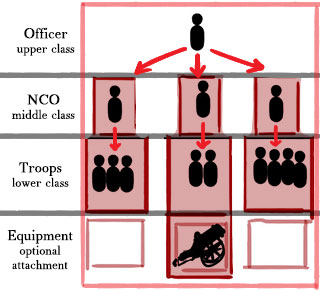
Mjr. General Ogden Cogsbold’s timid manner is reflected in the behaviour of the entire regional military.
Clockwork Empires is a game about characters, not just the cold mechanics of supply chains and industry. Therefore the character of your soldiers must be essential to the outcome of combat. In the post about overseers and work crews it was implied that the character of an overseer is reflected in the performance of the work crew they lead. It’s just the same for military squads with NCO and officer leadership of military squads having an even greater effect which we call “Command Disposition”. And I daresay, the hierarchical theme of top-down leadership fits nicely into 19th century military doctrine.
Now, the Command Disposition — in addition to how a squad is manned — can act a bit like scripting orders for squads like some kind of really lightweight version of Dominions 3 tactical combat. Assign a bookish and stubborn NCO to a squad and they’ll tend to be defensive and stick to their trenches. Assign an aggressive, violently-inclined NCO to the same squad and they become more likely to order a bayonet charge against the enemy. There’s a bit more to it than that of course; equipment has an effect, so Steam Armour equipped squads will be used for the role of assaulting defenses and artillery equipped squads will stay back and merrily bombard the enemy.
(I will also admit here that the random leader personality trait generation of Paradox‘s Victoria as well as Hearts of Iron III’s command structure system have had a good bit of effect on my thinking.)
It is worth stating of course that the personalities and interactions of characters is a whole system unto itself which has effects that are felt in combat which is a subject which deserves a post of its own.
Managing Defeat
For many combat games, once the sequential play-through has its reloads trimmed off, the timeline looks like a straight line of victory after victory after victory. The player has power over some kind of quantum multiverse which allows them to select the timeline in which they won every battle. In contrast, we want players of Clockwork Empires to be able to fail, but we want it to be a rewarding experience to fail. As we keep saying in interviews, “Things going spectacularly wrong makes a great story.” Remember the Alamo, the Charge of the Light Brigade, the Battle of Isandlwana, and Dredmor’s planned release date!
Defeat should be a bloody good story. A player who keeps a stiff upper lip and endures defeat should be rewarded with narrative richness. And that said, we game designers should be nice enough not to punish them by making their entire game collapse because a squad of soldiers had a bad day. So we must soften defeat from the traditional red mist and bone chips model that’s had such a strong tradition in games.
So: Combat won’t be a meat-grinder. The Starcraft-style RTS has its soldiers eagerly fighting to the death – and always to the death. In CE an individual character’s willingness to fight affects whether they will actually stick around to fight. Sometimes a coward is a coward, but a player can stack the odds in their favour by choosing the right military leadership, setting their squads in good defensive positions, keeping troops well supplied, and doing everything else they can to keep moods positive.
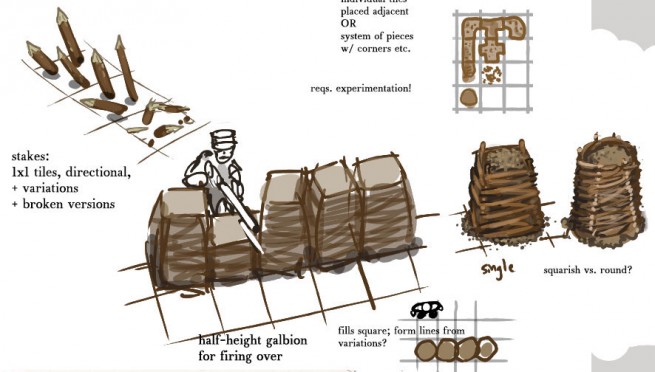
Concepts for field fortifications based on American Civil War era gabions which I spelled “galbion” and know is incorrect so no one has to correct my spelling now, thanks.
It must be said that with all the character-driven action in mind, there’s very much a balance to be struck between characters’ willingness to follow orders and the player being able to actually play the game in any meaningful sense. This goes for civilians as well because if your lumberjacks are more interested in dancing jigs and drinking gin than ever getting to work, this game is going to get really frustrating.
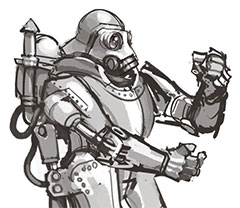
Pictured: Steam Knight pulling on invisible rope.
Back to the subject of defeat: Even victory can be made expensive to slow down runaway success. Combat actions wear down characters’ stamina, and suppressing fire saps willingness to act – perhaps in the manner of Jagged Alliance 2 in which suppressing fire would actually reduce action points. When in a tight spot, buy some time with ammunition! (Though supplies are limited and must be properly restocked.) Further, the best combat positions are of course immobile defensive works in the grand tradition of something between the American Civil War and World War 1. Anything strong enough to punch through those static defenses, be it artillery batteries or Steam Knights, requires a solid supply of fuel and munitions which in turn requires careful use of terrain, guarded flanks, and measured advances. (By the way, these logistical themes are explored elegantly in Unity of Command. Hi Tomislav!)
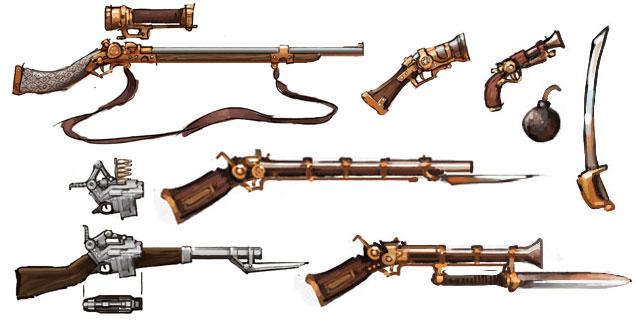
Not pictured: the Lightning Gun.
Right! Well, there’s more to it than all that: equipment, types of soldiers, the exact personality traits which affect combat, types of units via squad equipment attachments, the role of armour and artillery and static defenses, psychological effects of combat, and of course how the heck the UI for all of this is going to work. It’s all very early in the design process and what we’ve got here is largely a statement of goals & high-level plans for how to meet those goals using the other systems in the game as a framework. The details are very much subject to iteration as the game hits testing so there’s not much use in getting into the gritty specifics. But in all I hope this has given you an idea about where we’re planning to go with combat in Clockwork Empires.
Q. What, no cavalry? A. Not on horses, no. The Gaslamp Way does not involve doing anything so mundane. Plus it’s actually really hard to animate horse cavalry properly in limited space. The Mount & Blade or perhaps Total War series are about the closest you’re likely to get at this point. That said, keep in mind: Nothing So Mundane As That.
Q. Are there tanks? A. Of course, because what else would Steam Knights keep their high-pressure steam in? (Surely you’re not referring to those burdensome Stahlmarkian Landkreuzers?)
Q. Can you fight your friends in multiplayer? A. Naturally, and didn’t we cover this already? Every Gaslamp Games Press Release is Totally Serious About Everything.

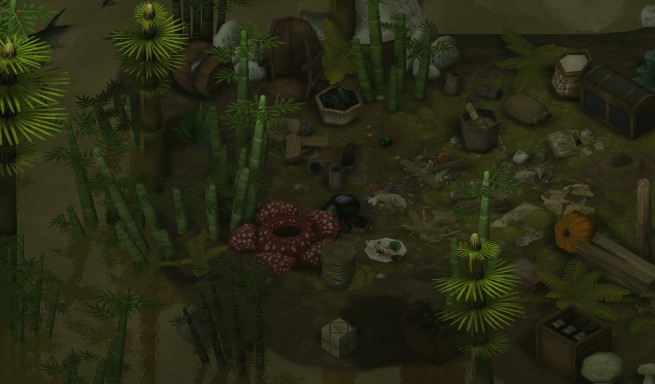





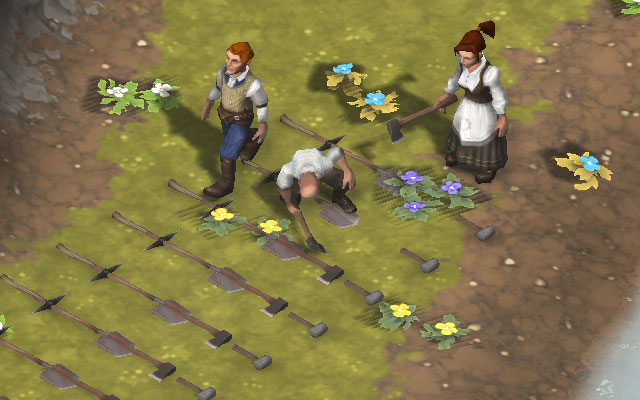

April Technical Status Update
It’s April! There is a Technical Status Update. You know the drill.
{ read this article }
23 Comments